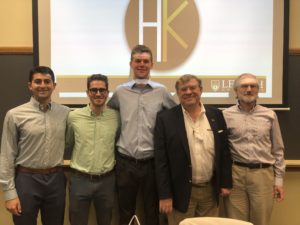Swipe. Error. Clear.
Swipe. Error. Clear.
Swipe. Error. Clear.
The Saxby’s cashier pulled a piece of parchment paper out from under the register. He wrapped it around the Lehigh ID and put it through the GoldPLUS machine again.
“Medium iced coffee for Aaron,” a barista shouted.
Aaron Rotem, ‘19, waited patiently at the register as the cashier continued to swipe his card. He turned to see the line growing rapidly. Finally, the payment went through and he grabbed the coffee that was ready before he even paid.
If only there was a better way.

From left, Aaron Rotem ’19, Tim La Rowe ’19, Matt Addessi ’19, Synaptic Consulting CTO Jeff Anthony and Professor Hank Korth are all collaborating together on a potential replacement to upgrade the current GoldPLUS system in place by Lehigh. This project was developed as a part of the Computer Science and Business program. (Alexis McGowan/B&W Staff)
Rotem, Matt Addessi, ‘19, and Tim LaRowe, ‘19, have been working for a year on HawKoin, a potential replacement and upgrade to the current GoldPLUS system.
The HawKoin team presented its project to the CSE 297 class, “Blockchain Algorithms and Systems,” in Packard Lab on Monday, Dec 3.
The project was developed by Hank Korth, a professor of computer science and engineering, and Synaptic Consulting CTO Jeffrey Anthony as part of the computer science and business (CSB) program’s culminating capstone class. Both have been mentors to the team.
“The purpose of the (project) is to solve a real problem in a real business for real people,” Korth said.
Currently, GoldPLUS uses dial-up technology to complete payments and every transaction is processed through a third party.
While it is still in the developmental stages, HawKoin would be an on- and off-campus payment option that uses blockchain technology.
Using blockchain would allow transactions to be quicker and more secure.
“It’s a multi-year project that’s very research heavy,” Addessi said.
If implemented, there could be benefits for the university, students and vendors.
Lehigh would no longer have to pay a third-party or licensing fee for each user, as they do now for GoldPLUS, cutting their costs dramatically. On top of the money Lehigh would save, it would even have an opportunity to profit if it chose to charge rates competitive with those of credit card companies.
Students would have a faster, more secure payment method that would be accessible from their Google accounts on their phones. Rather than using Lehigh ID cards, HawKoin transactions would be done via QR code.
There would be a much lower transaction fee for vendors using HawKoin. Currently, vendors are charged about five percent on every transaction with GoldPLUS, which is almost twice as expensive as a regular credit card transaction fee.
“There could be a zero percent (transaction fee),” LaRowe said. “It could be the same as cash.”
The HawKoin team spent last semester interviewing all possible stakeholders to decide which features they wanted to ensure their payment-alternative had. The team also met with the GoldPLUS Office to understand the dial-up technology used for transactions.
Team members also conducted research on both the technical and business sides to find the best technology to use. Once they gathered their data, they began looking at how to develop their platform. After lots of analysis and debate, they landed on Hyperledger Fabric, a technology used by companies like Morgan Stanley and IBM.
Rotem said Hyperledger Fabric is a distributed ledger that uses blockchain concepts to mesh the benefits of blockchain technology with the needs of a private institution.
Throughout the semester, Addessi, LaRowe and Rotem met weekly and planned “sprints,” or goals, for the development of the code.
During their presentation, they outlined the various phases of the project. The HawKoin team demonstrated how transactions would work and explained some of the features of their code.
After the presentation, Anthony said he was proud to have been a mentor to this team because their teamwork and effort paid off.
While Addessi, LaRowe and Rotem’s capstone is officially done as a class requirement, there are still many stages of development that are necessary before HawKoin can become a reality on campus. The team recognizes this, and made a point of outlining next steps in their presentation.
The entire team, including Anthony and Korth, is hoping the project will continue as a capstone and a new group of students will take the reigns in the spring.
“If the group that will be working on it next wants help, I’ll always be there because we’ve been working on this for the past year and it’s a really exciting project,” Rotem said. “I would love to see this project finished and get implemented and actually impact students’ lives on campus.”





Comment policy
Comments posted to The Brown and White website are reviewed by a moderator before being approved. Incendiary speech or harassing language, including comments targeted at individuals, may be deemed unacceptable and not published. Spam and other soliciting will also be declined.
The Brown and White also reserves the right to not publish entirely anonymous comments.
2 Comments
Many thanks for this wonderful article! I especially love the witty lead-in!
The students you feature in the article are well deserving of the recognition and accolades they are receiving for the meticulous and professional-grade work they have done over the last year in a very advanced, leading-edge technology. Despite my high expectations from the very beginning, I never ceased to be amazed by how very hard they worked and how extraordinarily fruitful their work was. Not only that, but they’re the nicest fellows you could ever hope to meet. Also (as if it could be any better than that), collaborating with the renowned and deeply committed Professor Korth was a wonderful and rewarding personal and professional privilege and pleasure.
For more than a decade, it’s been my great honor to be involved with the Computer Science and Business (CSB) program’s Capstone Course in a variety of roles — teaching, advising, and sometimes sponsoring projects. My firm, Synaptic Consulting, is deeply proud of our long association with Lehigh University, its faculty, and its students as part of our ongoing corporate commitment to education and community, and we enthusiastically look forward to continuing that unfailingly rewarding relationship for many years to come…
Jeffrey Anthony
Synaptic Consulting
Partner and CTO
I see that relationship didn’t last much longer than this comment LOL